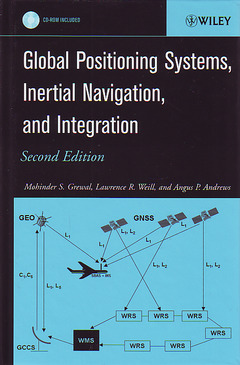Description
Global positioning systems, inertial navigation & integration with CD-ROM (2nd Ed.)
Authors: GREWAL Mohinder S., WEILL Lawrence R.
Language: English
Subjects for Global positioning systems, inertial navigation &...:
Approximative price 111.61 €
Subject to availability at the publisher.
Add to cart
Publication date: 01-2007
458 p. · Hardback
458 p. · Hardback
Description
/li>Contents
/li>
The Global Positioning System (GPS) may be used in conjunction with Inertial Navigation Systems (INS) for tracking and navigation. GPS and Inertial Navigation find applications in the civilian and military sectors to track devices, to locate people and objects, in the air, on the ground, or at sea. GPS devices are used by law enforcement agencies and emergency services This second edition of Global Positioning Systems, Inertial Navigation, and Integration addresses state of the art technologies, including detailed attention to integrity of design not covered in currently published books.
Preface. Acknowledgments. Dedication. Acronyms. 1 Introduction. 1.1 GNSS/INS Integration Overview. 1.2 GNSS Overview. 1.3 Differential and Augmented GPS. 1.4 Space-Based Augmentation Systems (SBASs). 1.5 Applications. 2 Fundamentals of Satellite and Inertial Navigation. 2.1 Navigation Systems Considered. 2.2 Fundamentals of Inertial Navigation. 2.3 Satellite Navigation. 2.4 Time and GPS. 2.5 Example GPS Calculations with no Errors. 3 Signal Characteristics and Information Extraction. 3.1 Mathematical Signal Waveform Models. 3.2 GPS Signal Components, Purposes, and Properties. 3.3 Signal Power Levels. 3.4 Signal Acquisition and Tracking. 3.5 Extraction of Information for Navigation Solution. 3.6 Theoretical Considerations in Pseudorange and Frequency Estimation. 3.7 Modernization of GPS. 4 Receiver and Antenna Design. 4.1 Receiver Architecture. 4.2 Receiver Design Choices. 4.3 High-Sensitivity-Assisted GPS Systems (Indoor Positioning). 4.4 Antenna Design. 5 Global Navigation Satellite System Data Errors. 5.1 Selective Availability Errors. 5.2 Ionospheric Propagation Errors. 5.3 Tropospheric Propagation Errors. 5.4 The Multipath Problem. 5.5 How Multipath Causes Ranging Errors. 5.6 Methods of Multipath Mitigation. 5.7 Theoretical Limits for Multipath Mitigation. 5.8 Ephemeris Data Errors. 5.9 Onboard Clock Errors. 5.10 Receiver Clock Errors. 5.11 Error Budgets. 5.12 Differential GNSS. 5.13 GPS Precise Point Positioning Services and Products. 6 Differential GNSS. 6.1 Introduction. 6.2 Descriptions of LADGPS, WADGPS, and SBAS. 6.3 Ground-Based Augmentation System (GBAS). 6.4 GEO Uplink Subsystem (GUS). 6.5 GUS Clock Steering Algorithms. 6.6 GEO with L1/L5 Signals. 6.7 New GUS Clock Steering Algorithm. 6.8 GEO Orbit Determination. 7 GNSS and GEO Signal Integrity. 7.1 Receiver Autonomous Integrity Monitoring (RAIM). 7.2 SBAS and GBAS Integrity Design. 7.3 SBAS example. 7.4 Conclusions. 7.5 GPS Integrity Channel (GIC). 8 Kalman Filtering. 8.1 Introduction. 8.2 Kalman Gain. 8.3 Prediction. 8.4 Summary of Kalman Filter Equations. 8.5 Accommodating Time-Correlated Noise. 8.6 Nonlinear and Adaptive Implementations. 8.7 KalmanBucy Filter. 8.8 GPS Receiver Examples. 8.9 Other Kalman Filter Improvements. 9 Inertial Navigation Systems. 9.1 Inertial Sensor Technologies. 9.2 Inertial Systems Technologies. 9.3 Inertial Sensor Models. 9.4 System Implementation Models. 9.5 System-Level Error Models. 10 GNSS/INS Integration. 10.1 Background. 10.2 Effects of Host Vehicle Dynamics. 10.3 Loosely Coupled Integration. 10.4 Tightly Coupled Integration. 10.5 Future Developments. Appendix A: Software. A.1 Software Sources. A.2 Software for Chapter 3. A.3 Software for Chapter 5. A.4 Software for Chapter 8. A.5 Software for Chapter 9. A.6 Software for Chapter 10. Appendix B: Vectors and Matrices. B.1 Scalars. B.2 Vectors. B.3 Matrices. B.4 Matrix Operations. B.5 Block Matrix Formulas. B.6 Functions of Square Matrices. B.7 Norms. B.8 Factorizations and Decompositions. B.9 Quadratic Forms. B.10 Derivatives of Matrices. Appendix C: Coordinate Transformations. C.1 Notation. C.2 Inertial Reference Directions. C.3 Coordinate Systems. C.4 Coordinate Transformation Models. References. Index.
© 2024 LAVOISIER S.A.S.




